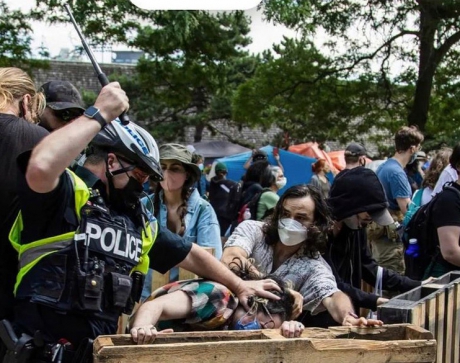Columns
You are here
Homeless and under attack

November 29, 2021
London, Ontario has always taken better care of its golfers than its vulnerable population. There are 53 courses in and around London, including several municipal courses.
Such is the competition, that city owned River Road course fell into disuse. Early in 2021 city council decided to close the facility and try to sell the land. Problem: most of that land is on the Thames River flood plain and not suitable for housing.
An Indigenous-led organization came forward with a plan to turn the course and clubhouse into a healing centre for unhoused Indigenous people. Atlohsa Family Healing Services had plans to house 30 people this winter, using the grounds as an area for residents to reconnect with nature.
On November 7 a suspicious fire caused more than $1 million damage to the River Road clubhouse.
Within days, police charged Michael Peter Belanger with arson. Belanger, a senior city employee, was a neighbour trying to sell his house who decided the planned centre would lower his property value. So he went full NIMBY.
No liberty in Liberty Village
In Toronto’s Liberty Village neighbourhood, the old warehouse district has been gentrified. Shabby garrets and artist’s studios have been replaced by luxury “lofts” and high-end condo towers.
A small group of homeless people regularly gathered at night under a pedestrian/cycle bridge to pitch their tents and take shelter.
On the evening of November 19 the encampment was gutted by what was described as an “explosive” fire. Luckily no one was seriously injured.
The following morning, City spokesperson Brad Ross was all over the media, using the event to attack the tent encampments proliferating in parks and unused lands. He touted City-run shelters as a better, safer alternative. He blamed the homeless for the fire, the old trick of blaming the victims.
But luckily there was video of the event, showing a man clad all in black, arriving at the encampment and setting the fire with gas-soaked rags. Vincze Laszio travelled all the way across the city, from Scarborough to the west side, to set the fire. He has been charged with arson causing damage to property, common nuisance, mischief over $5,000, and possession of incendiary material.
Brad Ross was noticeable in his absence the next day, to apologize for jumping the gun and blaming the victims of the arson. But that is consistent with the city’s unwritten policy toward the growing army of homeless workers: turn a blind eye, because their labour is needed; increase funding for policing instead of providing safety equipment for encampments; loudly amplify every incident as proof of the inherent unsafety of encampments; and launch para-military attacks when encampments grow too big.
Residents are scattered, their few belongings destroyed, but nothing is done to address the problem. The cycle of abuse and violence against the homeless repeats.
People working with the homeless say the arson attack is not unique. There are occasional small fires, from carelessness or attempts to keep warm. But major blazed that occur are, they charge, deliberately set.
The November fire at Liberty Village was not the first. In May, major blazes at this encampment and at Lamport Stadium were recorded. Officials, from the Mayor on down, never conceded the possibility that these were arson attacks against the homeless. No, they were convenient reminders that encampments were “unsafe, unhealthy and illegal”.
Shelter?
People in these encampments are homeless, they aren’t stupid. Whether charity or municipally run, shelters are brutal, unsafe environments, especially during the pandemic. Lack of privacy and dignity, violence, theft, strict times for arrival and morning departure: these are standard.
Accounting just for housing costs, Vancouver has become the most expensive city in North America. Toronto is #5. As the cost of living in the city skyrockets, many of the inhabitants of our tent encampments are working at low-paying jobs.
In a system that refuses either to pay a living wage or guarantee truly affordable housing, tent encampments become essential. Many homeless workers find tent cities are far better options than warehouse-style shelters, even in our brutal winter conditions. They provide a minimum of privacy and the ability to come and go according to the needs of employment, not rigid shelter rules. And they provide community, with people watching out for each other’s few belongings.
Much of the time the encampments are conveniently ignored, subject to minor harassment rather than major confrontation. But the City has consistently used fire safety as an excuse to violently attack them on occasion.
The most egregious example was the para-military assault on the large encampment in Toronto’s Alexandra Park in July. Nine people were arrested and dozens were uprooted, their possessions confiscated and destroyed. The justification was that neighbours were deprived use of the park. But the day after the clearance the park was fenced off – it had been rented to movie company as a location for filming.
Street pastor Doug Johnson Hatlem scoffed at the idea that the City is concerned about safety: “It’s overriding concern is to disappear these encampments, to make them invisible, to make homelessness an invisible issue. If it was about safety, their actions would be much, much different.”
One last issue: arsonists like Belanger and Laszio deliberately targeted the homeless. One’s motive was greed, and perhaps a scoop of racism on the side. The other’s motive is unclear. My question is: do they feel their violence against the vulnerable is justifiable when they witness the use of police force and violence used to clear encampments?
Whatever the answer, as I write there has been a major fire at a Hamilton encampment. It is not being investigated for arson. Police have used it as an excuse to disperse the homeless. To make them invisible.
Section:










